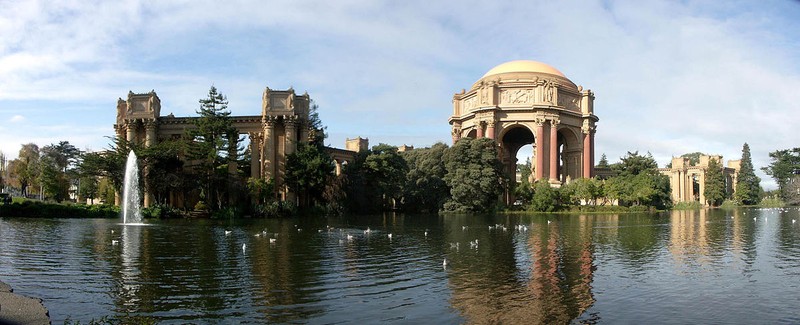Palace of Fine Arts Theatre
Introduction
Text-to-speech Audio
Images
This Palace of Fine Arts was built in 1915 for the Panama-Pacific Exposition to showcase artwork. It remains a popular attraction for locals and tourists alike.

Backstory and Context
Text-to-speech Audio
The 1915 World's Fair, known as the Panama-Pacific International Exposition (PPIE) was held in San Francisco between February 20 and December 4, 1915. The main purpose of the event was to celebrate the successful completion of the Panama Canal, and was seen as an opportunity for the city to celebrate its recovery from the 1906 earthquake. A 635-acre site was chosen to host the fair along the Northern shore between Fort Mason and the Presidio, what is now the Marina District. The Palace of Fine Arts was one of ten palaces constructed for the exhibition. The other palaces were for Education, Liberal Arts, Manufacturing, Varied Industries, Agriculture, Food Products, Transportation, Mines and Metallurgy, and the Palace of Machinery.
The Palace of Fine Arts was designed in a Roman/Greek style by architect Bernard Maybeck, with the palace itself resembling an ancient ruin. After the exposition, most of the new buildings were demolished, however the Palace of Fine Arts was allowed to remain thanks to the work of the Palace Preservation League.
For a long time after the exhibition was over, the Palace was still used as an art exhibit. During the Great Depression, the decaying Robert Reid murals on the rotunda had to be replaced. From 1934 to 1942 the exhibition hall was home to eighteen lit tennis courts. And during the Second World War the building was requisitioned for the military to use for vehicle storage. From 1947 on the hall was put to various uses: as a city Park Department warehouse; as a telephone book distribution center; as a flag and tent storage depot; and even as temporary Fire Department headquarters. By the 1950s the Palace, which had only been built to last a short time, was becoming a real crumbling ruin.
For this reason, the Palace was completely demolished in 1964, with only the exhibit halls' steel structure remaining. The buildings were subsequently reconstructed in a new permanent and light-weight structure. All of the decorations and sculptures were recreated and constructed anew.
In 1969 the old exhibit hall became an exploratorium, and the next year became home to the 966 seat Palace of Fine Arts Theatre. In 2003 the City of San Francisco decided to restore the Palace, and by 2010 all of the works had been completed. In 2013, the exploratorium closed and moved to the Embarcadero.
Sources
"Palace of Fine Arts." SF Rec Park. Accessed April 06, 2017. http://sfrecpark.org/destination/palace-of-fine-arts.
"Palace of Fine Arts Theater." Bay Area Spaces. Accessed April 06, 2017. http://bayareaspaces.org/spaces/2695.
"Theater History." Palace of Fine Arts Theater. Accessed April 06, 2017. https://www.palaceoffinearts.org/theatre-history.
